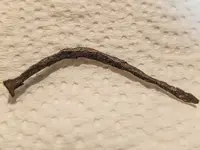PBrad
Greenie
- Joined
- Jan 7, 2016
- Messages
- 16
- Reaction score
- 37
- Golden Thread
- 0
- Location
- Fort Hood, TX
- Detector(s) used
- Garrett AT Pro, AT Pro Pointer
- Primary Interest:
- All Treasure Hunting
I had today off so I was able to go out exploring some local areas. One of them was the site of an old college that was in operation from 1860-1885. All that is left now are just ruins. A chimney, a masonic corner stone, and a few partial walls. Didn't get many hits with the AT Pro as I am pretty sure it's been picked clean all these years as they're trying to preserve it. I found a few caps, an old tin can, and a square nail. I'm assuming that this nail is from the same time period from what I have read. My first relic?


Upvote
8



 .
.
